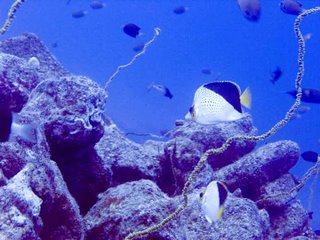
Pardon the wierd post title, just giving the search engines something to recognize.
Yesterday we had a diver, with family doing an intro on board. It's always fun to introduce people to diving. Bob lead both dives. The first dive was at Turtle Haven, there were plenty of turtles, as well as an eagle ray and other goodies. The second dive was at a spot Bob and I know as "Tako Bell". It's also called Kaloko Ponds, Inside Kaloko, Lures (after a fishing boat that sank there years ago) and such. "Tako" is what the locals call octopus. I think it's pretty much the japanese name for the critter.
I've met our divers for the next few days, they're staying in our vacation rental. It should be a lot of fun on the water with them.
I finally broke down and tried taking some RAW photos underwater with my camera. RAW is a file format that some cameras can use that is more or less uncompressed. It takes forever (well 10 seconds or so, seems like forever) for my camera to write a photo to RAW, so you can't take any more pics 'til the writing is done unless you have it in burst mode. My version of photoshop supports RAW, but I never downloaded the update for my camera. I took some RAW pics on our trip and again the other day and Pat (much more computer literate than I) helped my download the update and get it in the proper file to work.
RAW is cool. You can play with exposure, color, sharpness, white balance and other things I've yet to understand after the fact... before sending it to your edidting program. Makes for a bit more work on editing, and more waiting when taking photos, but if I can tolerate the waiting I'll be shooting more RAW. I won't have to go through all the custom white balance gyrations I've had to do.
Here's a photo of those Tinker's Butterflyfish (Chaetodon tinkeri) we saw the other day. This pic was taken at 104' and I can't effectively manual white balance at that depth. The RAW photos can get to pretty close to accurate after the fact though, this one could probably still use a little editing work, but it's good enough for me. The long, slender stick-like things coming out of the rock are know as whip coral or wire coral. We find them in lots of spots below 85-100 feet. If you go back through the blog archives, you'll find a pic of a whip coral goby. Those gobies will pretty much spend their entire lives on a whip coral.
Later,
Steve
2 comments:
like the blog. I love diving but not yet into photography. Wish more divers would post their pic and dive stories.
Thanks for the comment. The photography thing gets addictive once you start.
Steve
Post a Comment